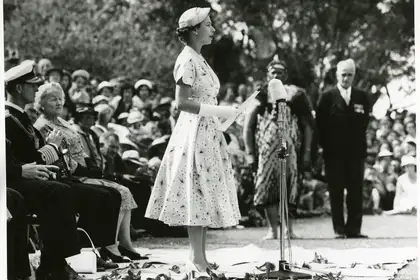
Queen Elizabeth II at Waitangi in 1953
Queen Elizabeth II’s passing marks the end of a period of extraordinary change for Aotearoa New Zealand.
As a young Queen, she came to New Zealand in 1953 in an astonishing outpouring of affection as the first reigning monarch to visit these islands. Towns were brushed up, buildings repainted and bunting laid. It seemed the entire country turned out waving Union Jacks rather than New Zealand’s Southern Cross to see the young Queen and her husband. In what must have been a wearying trip, she accepted bouquets of flowers, listened to dry speeches of loyalty and expressed her appreciation for her welcome in almost every town from Kaikohe to Invercargill, all in a fortnight. Māori welcomes were planned for Waitangi and Rotorua, until Ngāruawāhia was included at the last minute. These too were extraordinary events.
She and her husband Prince Philip represented a new generation. They were a young family, participants in World War II, and looking forward to a new and better post-war world.
A succession of wars, recessions, industrial and other conflicts, eroded that confidence. Over her time as Queen, she came to know more prime ministers and heads of state than anyone ever before her. Her most difficult, and in many ways successful role, was presiding over the dissolution of the British Empire, begun in the reign of her father with the violent partition of India, into India and Pakistan in 1947. She successfully navigated her way through a far from peaceful and trouble-free transition, while standing above the mayhem that came with it.
As titular head of the Commonwealth, her commitment to recognising the interests of newly independent African, Asian and Caribbean states brought her into conflict with her own British prime ministers, and in particular Margaret Thatcher and her resistance to the Commonwealth’s views on decolonisation in Southern Africa. She has watched her British prime ministers dismantle its Empire and then take Britain into Europe and out again.
The muted demands for New Zealand to be become a republic is a testimony to her success as head of state in a country halfway round the world and increasingly different from that which greeted her so enthusiastically in 1953. She did her job, did it well, and somebody else pays most of the bills.
More recent visits from the Queen have been treated more ambiguously, particularly her 1990 visit when her role as monarch was seen by some as a symbol of colonisation and the failure of her governments in New Zealand to honour its commitments under Te Tiriti o Waitangi.
Most important of her recent visits was her return to Tūrangawaewae in 1995 to make an apology for the invasion and confiscation of Tainui land during the New Zealand Wars. She met with another Queen, Te Arikinui Dame Te Atairangikaahu, whose father Korokī Te Rata Mahuta Tawhiao Potatau Te Wherowhero, the fourth Māori King, had welcomed her to Ngāruawahia in 1953. The two women personally reset the relationship so damaged by the invasion of Waikato and the confiscation of land which followed in the 1860s, under the name of Queen Elizabeth’s great-great-grandmother, Queen Victoria. In 1953, King Korokī had sought from the Queen a promise of mana motuhake, self-determination, and this was one small step on the way to achieving that.
Her Majesty made the monarchy more accessible and to the vast numbers of those who met or saw her, however fleetingly over our lifetimes, she was a source of stability in an unstable world.